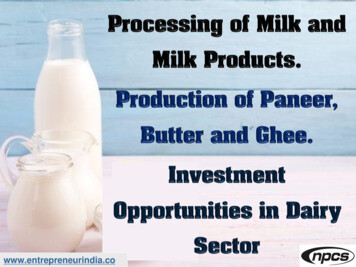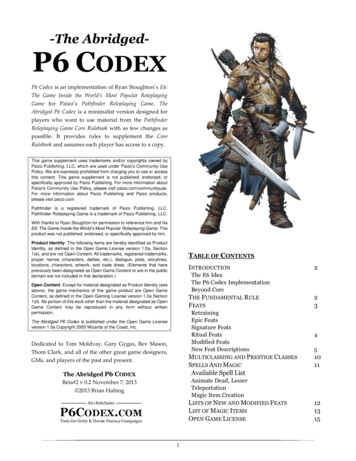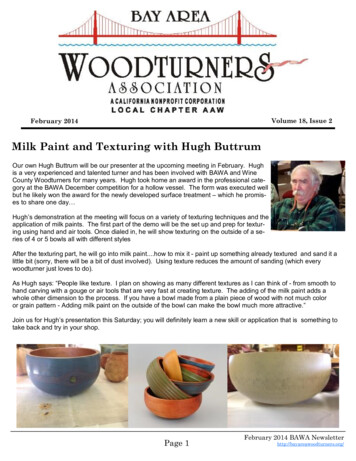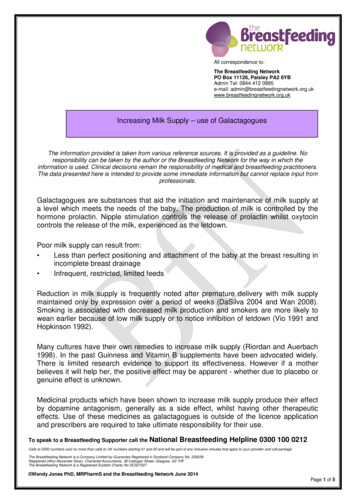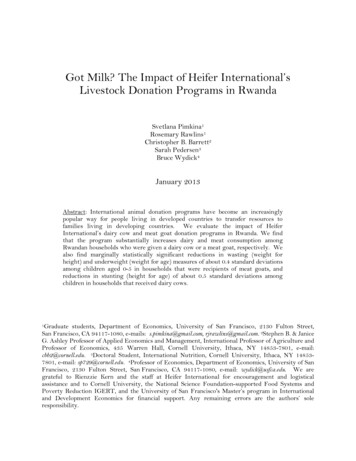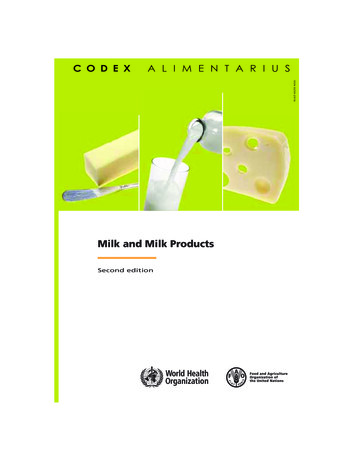
Transcription
ISSN 0259-2916Milk and Milk ProductsSecond edition
Milk and Milk ProductsSecond editionWORLD HEALTH ORGANIZATIONFOOD AND AGRICULTURE ORGANIZATION OF THE UNITED NATIONSRome, 2011BOOK.indb i24/10/2011 12.14.19
The designations employed and the presentation of material in this informationproduct do not imply the expression of any opinion whatsoever on the part of theFood and Agriculture Organization of the United Nations (FAO) or of the World HealthOrganization (WHO) concerning the legal or development status of any country,territory, city or area or of its authorities, or concerning the delimitation of its frontiers orboundaries. The mention of specific companies or products of manufacturers, whetheror not these have been patented, does not imply that these have been endorsed orrecommended by FAO or WHO in preference to others of a similar nature that are notmentioned.ISBN 978-92-5-105837-4All rights reserved. Reproduction and dissemination of material in this informationproduct for educational or other non-commercial purposes are authorized withoutany prior written permission from the copyright holders provided the source is fullyacknowledged. Reproduction of material in this information product for resale or othercommercial purposes is prohibited without written permission of the copyright holders.Applications for such permission should be addressed to:ChiefElectronic Publishing Policy and Support BranchCommunication DivisionFAOViale delle Terme di Caracalla, 00153 Rome, Italyor by e-mail to:copyright@fao.org FAO and WHO 2011BOOK.indb ii24/10/2011 12.14.21
The Codex Alimentarius Commission is an intergovernmental body with over 180members established by the Food and Agriculture Organization of the UnitedNations (FAO) and the World Health Organization (WHO).The C O D E X A L I M E N T A R I U S is the main result of the Commission’swork: a set of international food standards, guidelines and codes of practicewith the goal to protect the health of consumers and ensure fair practices in thefood trade.PREFACETHE CODEX ALIMENTARIUS COMMISSIONMILK AND MILK PRODUCTSSecond editionThis compilation contains in one volume all Codex standards and related textsfor milk and milk products adopted by the Codex Alimentarius Commission upto 2011.Further information on these texts, or any other aspect of the Codex AlimentariusCommission, may be obtained from:Secretariat of the Codex Alimentarius CommissionJoint FAO/WHO Food Standards ProgrammeViale delle Terme di Caracalla00153 Rome, ItalyFax: 39 06 57054593E-mail: codex@fao.orghttp:// www.codexalimentarius.orgBOOK.indb iii19/11/2011 16.00.21
iiiStandards for milk productsMilk powders and cream powder (CODEX STAN 207-1999)1Fermented milks (CODEX STAN 243-2003)6Blend of evaporated skimmed milk and vegetable fat (CODEX STAN 250-2006)17Blend of skimmed milk and vegetable fat in powdered form (CODEX STAN 251-2006)21Blend of sweetened condensed skimmed milk and vegetable fat (CODEX STAN 252-2006)25Dairy fat spreads (CODEX STAN 253-2006)29Butter (CODEX STAN 279-1971)36Milkfat products (CODEX STAN 280-1973)38Evaporated milks (CODEX STAN 281-1971)41Sweetened condensed milks (CODEX STAN 282-1971)45Cream and prepared creams (CODEX STAN 288-1976)49Whey powders (CODEX STAN 289-1995)56Edible casein products (CODEX STAN 290-1995)59CONTENTSPREFACEHorizontal cheese standardsCheeses in brine (CODEX STAN 208-1999)64Group standard for unripened cheese including fresh cheese (CODEX STAN 221-2001)67Extra hard grating cheese (CODEX STAN 278-1978)73General standard for cheese (CODEX STAN 283-1978)76Standard for whey cheeses (CODEX STAN 284-1971)83Individual cheese standardsMozzarella (CODEX STAN 262-2006)86Cheddar (CODEX STAN 263-1966)93Danbo (CODEX STAN 264-1966)99Edam (CODEX STAN 265-1966)104Gouda (CODEX STAN 266-1966)109Havarti (CODEX STAN 267-1966)115Samsø (CODEX STAN 268-1966)120Emmental (CODEX STAN 269-1967)125Tilsiter (CODEX STAN 270-1968)131Saint-Paulin (CODEX STAN 271-1968)136Provolone (CODEX STAN 272-1968)142Cottage cheese (CODEX STAN 273-1968)148Coulommiers (CODEX STAN 274-1969)154Cream cheese (CODEX STAN 275-1973)159Camembert (CODEX STAN 276-1973)166Brie (CODEX STAN 277-1973)171General texts for milk and milk productsGeneral standard for the use of dairy terms (CODEX STAN 206-1999)176Code of hygienic practice for milk and milk products (CAC/RCP 57-2004)181Guidelines for the preservation of raw milkBOOK.indb vby use of the lactoperoxidase system (CAC/GL 13-1991)233Model export certificate for milk and milk products (CAC/GL 67-2008)24019/11/2011 16.00.22
CODEX STANDARD FOR MILK POWDERSAND CREAM POWDERCODEX STAN 207-19991. SCOPEThis Standard applies to milk powders and cream powder, intended for directconsumption or further processing, in conformity with the description in Section 2 ofthis Standard.2. DESCRIPTIONMilk powders and cream powder are milk products which can be obtained by thepartial removal of water from milk or cream. The fat and/or protein content of the milkor cream may have been adjusted, only to comply with the compositional requirementsin Section 3 of this Standard, by the addition and/or withdrawal of milk constituents insuch a way as not to alter the whey protein to casein ratio of the milk being adjusted.3. ESSENTIAL COMPOSITION AND QUALITY FACTORS3.1 Raw materialsMilk and creamThe following milk products are allowed for protein adjustment purposes:– Milk retentate Milk retentate is the product obtained by concentratingmilk protein by ultrafiltration of milk, partly skimmed milk,or skimmed milk;– Milk permeate Milk permeate is the product obtained by removing milkproteins and milkfat from milk, partly skimmed milk, orskimmed milk by ultrafiltration; and– Lactose1.3.2 CompositionCream powderMinimum milkfatMaximum water(a)Minimum milk protein in milk solids-not-fat(a)142% m/m5% m/m34% m/m1See Standard for Sugars (CODEX STAN 212-1999).This Standard replaced the Standard for Whole Milk Powder, Partly Skimmed Milk Powder and Skimmed Milk Powder (A-5-1971) andthe Standard for Cream Powder, Half Cream Powder and High Fat Milk Powder (A-10-1971). Adopted in 1999. Amendment 2010.BOOK.indb 124/10/2011 12.14.21
MILK AND MILK PRODUC TS (2nd Edition)Whole milk powderMilkfatMaximum water(a)Minimum milk protein in milk solids-not-fat(a)Minimum 26% and less than 42% m/m5% m/m34% m/mPartly skimmed milk powderMilkfatMaximum water(a)Minimum milk protein in milk solids-not-fat(a)More than 1.5% and less than 26% m/m5% m/m34% m/mSkimmed milk powderMaximum milkfatMaximum water(a)Minimum milk protein in milk solids-not-fat(a)1.5% m/m5% m/m34% m/m(a) The water content does not include water of crystallization of the lactose; the milk solids-not-fat contentincludes water of crystallization of the lactose.4. FOOD ADDITIVESOnly those food additives listed below may be used and only within the limits specified.INS no.Name of additiveMaximum levelStabilizers331332Sodium citratesPotassium citrates5 000 mg/kg singly or in combination,expressed as anhydrous substancesFirming agents508509Potassium chlorideCalcium chlorideLimited by GMPLimited by GMPAcidity regulators339340450451452500501Sodium phosphatesPotassium odium carbonatesPotassium carbonates5 000 mg/kg singly or in combinationexpressed as anhydrous substancesLecithinsMono- and diglyceridesof fatty acidsLimited by GMP2 500 mg/kgEmulsifiers3224712BOOK.indb 224/10/2011 12.14.21
MILK P OWDERS AND C RE AM P OWDER (CODE X STAN 207-1999)INS no.Name of additiveMaximum levelAnticaking 56559Calcium carbonateTricalcium phosphateTrimagnesium phosphateMagnesium carbonateMagnesium oxideSilicon dioxide, amorphousCalcium silicateMagnesium silicatesSodium aluminosilicateCalcium aluminium silicateAluminium silicate10 000 mg/kg singly or in combinationAntioxidants300301304320Ascorbic acid, LSodium ascorbateAscorbyl palmitateButylated hydroxyanisole500 mg/kg expressed as ascorbic acid100 mg/kg5. CONTAMINANTSThe products covered by this Standard shall comply with the Maximum Levelsfor contaminants that are specified for the product in the General Standard forContaminants and Toxins in Food and Feed (CODEX STAN 193-1995).The milk used in the manufacture of the products covered by this Standard shallcomply with the Maximum Levels for contaminants and toxins specified for milk by theGeneral Standard for Contaminants and Toxins in Food and Feed (CODEX STAN 1931995) and with the maximum residue limits for veterinary drug residues and pesticidesestablished for milk by the CAC.6. HYGIENEIt is recommended that the products covered by the provisions of this standard beprepared and handled in accordance with the appropriate sections of the GeneralPrinciples of Food Hygiene (CAC/RCP 1-1969), the Code of Hygienic Practice forMilk and Milk Products (CAC/RCP 57-2004) and other relevant Codex texts such asCodes of Hygienic Practice and Codes of Practice. The products should comply withany microbiological criteria established in accordance with the Principles for theEstablishment and Application of Microbiological Criteria for Foods (CAC/GL 21-1997).3BOOK.indb 324/10/2011 12.14.21
MILK AND MILK PRODUC TS (2nd Edition)7. LABELLINGIn addition to the provisions of the General Standard for the Labelling of PrepackagedFoods (CODEX STAN 1-1985) and the General Standard for the Use of Dairy Terms(CODEX STAN 206-1999), the following specific provisions apply:7.1 Name of the foodThe name of the food shall be:Cream powderWhole milk powderPartly skimmed milk powderSkimmed milk powderaccording to the compositionin Section 3.2Partly skimmed milk powder may be designated “Semi-skimmed milk powder” providedthat the content of milkfat does not exceed 16% m/m and is not less than 14% m/m.If allowed by national legislation or otherwise identified to the consumer in the countrywhere the product is sold, “whole milk powder” may be designated “full cream milkpowder” and “skimmed milk powder” may be designated “low fat milk powder”.7.2 Declaration of milkfat contentIf the consumer would be misled by the omission, the milkfat content shall be declaredin a manner found acceptable in the country of sale to the final consumer, either (i) asa percentage by mass, or (ii) in grams per serving as quantified in the label providedthat the number of servings is stated.7.3 Declaration of milk proteinIf the consumer would be misled by the omission, the milk protein content shall bedeclared in a manner acceptable in the country of sale to the final consumer, either as(i) a percentage by mass, or (ii) grams per serving as quantified in the label providedthe number of servings is stated.7.4 List of ingredientsNotwithstanding the provision of Section 4.2.1 of the General Standard for theLabelling of Prepackaged Foods (CODEX STAN 1-1985), milk products used only forprotein adjustment need not be declared.7.5 Labelling of non-retail containersInformation required in Section 7 of this Standard and Sections 4.1 to 4.8 of theGeneral Standard for the Labelling of Prepackaged Foods (CODEX STAN 1-1985), and, ifnecessary, storage instructions, shall be given either on the container or in accompanyingdocuments, except that the name of the product, lot identification, and the nameand address of the manufacturer or packer shall appear on the container. However,lot identification, and the name and address of the manufacturer or packer may bereplaced by an identification mark, provided that such a mark is clearly identifiablewith the accompanying documents.4BOOK.indb 424/10/2011 12.14.21
MILK P OWDERS AND C RE AM P OWDER (CODE X STAN 207-1999)8. METHODS OF SAMPLING AND ANALYSISSee CODEX STAN 234-1999.APPENDIX – ADDITIONAL INFORMATIONThe additional information below does not affect the provisions in the precedingsections which are those that are essential to the product identity, the use of the nameof the food and the safety of the food.Additional quality factorsWhole milkpowderTitratable aciditymax 18.0PartiallySkimmed milkskimmed milkpowderpowdermax 18.0max 18.0(ml-0.1 N NaOH/10 g-solids-not-fat)Scorched particlesSolubility index (ml)MethodSee CODEX STAN234-1999See CODEX STAN234-1999max Disc Bmax Disc Bmax Disc BSee CODEX STAN234-1999max 1.0max 1.0max 1.0See CODEX STAN234-19995BOOK.indb 524/10/2011 12.14.21
MILK AND MILK PRODUC TS (2nd Edition)CODEX STANDARD FOR FERMENTED MILKSCODEX STAN 243-20031. SCOPEThis standard applies to fermented milks, that is Fermented Milk including, HeatTreated Fermented Milks, Concentrated Fermented Milks and composite milk productsbased on these products, for direct consumption or further processing in conformitywith the definitions in Section 2 of this Standard.2. DESCRIPTION2.1 Fermented Milk is a milk product obtained by fermentation of milk, which milkmay have been manufactured from products obtained from milk with or withoutcompositional modification as limited by the provision in Section 3.3, by the action ofsuitable microorganisms and resulting in reduction of pH with or without coagulation(iso-electric precipitation). These starter microorganisms shall be viable, active andabundant in the product to the date of minimum durability. If the product is heattreated after fermentation the requirement for viable microorganisms does not apply.Certain Fermented Milks are characterized by specific starter culture(s) used forfermentation as follows:Yoghurt:Symbiotic cultures of Streptococcus thermophilus and Lactobacillusdelbrueckii subsp. bulgaricus.Alternate Culture Yoghurt:Cultures of Streptococcus thermophilus and any Lactobacillus species.Acidophilus Milk:Lactobacillus acidophilus.Kefir:Starter culture prepared from kefir grains, Lactobacillus kefiri,species of the genera Leuconostoc, Lactococcus and Acetobactergrowing in a strong specific relationship.Kefir grains constitute both lactose fermenting yeasts(Kluyveromyces marxianus) and non-lactose-fermenting yeasts(Saccharomyces unisporus, Saccharomy
The fat and/or protein content of the milk or cream may have been adjusted, only to comply with the compositional requirements in Section 3 of this Standard, by the addition and/or withdrawal of milk constituents in such a way as not to alter the whey protein to casein ratio of the milk being adjusted. 3. ESSENTIAL COMPOSITION AND QUALITY FACTORS 3.1 Raw materials Milk and cream The
